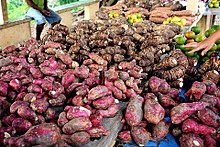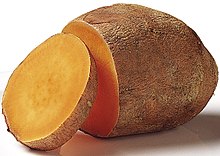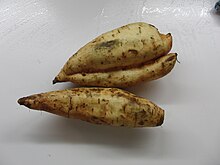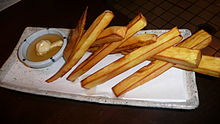sweet potato
| sweet potato | ||||||||||||
|---|---|---|---|---|---|---|---|---|---|---|---|---|

Sweet potato ( ipomoea batatas ) |
||||||||||||
| Systematics | ||||||||||||
|
||||||||||||
| Scientific name | ||||||||||||
| Ipomoea batatas | ||||||||||||
| ( L. ) Lam. |
The sweet potato ( Ipomoea batatas , even sweet potato , white potato or tuber winds called) is a useful plant belonging to the family of wind plants (Convolvulaceae) in the order of the nightshade-like part (Solanales). Above all, the underground storage roots, some of the leaves, are used as food . With an annual harvest of around 92 million tons (as of 2018), it ranks third in the world production of root and tuber food plants after potatoes ( Solanum tuberosum ) and cassava ( Manihot esculenta ); the largest producer is the People's Republic of China . The sweet potato is only distantly related to the potato, which belongs to the nightshade family.
description
Above-ground vegetative parts
The sweet potato is a perennial herbaceous climbing plant whose stems are usually slightly succulent , rarely slender and herbaceous. The stems usually creep on the ground and form adventitious roots at the nodes . Depending on the variety, the total length of a stem can be between 0.5 and 4 meters, some cultivars also form "sprouts" (botanically more precise: new young shoots) up to 16 meters in length. However, these do not form underground storage organs.
The leaves are screwed along the stems. The petiole is 5 to 20 inches long. The leaf blades are very variable, 5 to 13 centimeters long, the shape is heart-, kidney- to egg-shaped, rounded or triangular and spear-shaped, the edge can be entire, toothed or often three to seven times lobed, cut or divided . Most of the leaf surfaces are bare, rarely hairy, the tip is rounded to pointed. The leaves are mostly green in color, but due to the accumulation of anthocyanins, especially along the leaf veins , they can be purple in color.
Root system
Starting from different types of roots (the storage roots, fiber roots or the pencil roots) the root system of the sweet potato forms side roots. The fiber roots (thin adventitious roots ) arise mainly in internodial areas and have a typical four-part structure in which four xylem and phloem strands each form the conductive tissue . The thicker roots (pencil roots), however, have a five or six-part structure; they arise in the nodes of the underground parts of the stem axis . Depending on the living conditions above or below the surface of the earth, the pencil roots can become storage roots. However, if, for example, the nitrogen content of the earth is too high or the oxygen content is too low, pencil roots can also become fiber roots again.
Completely formed storage roots can vary in shape from almost spherical to long spindle-shaped; their length ranges from a few centimeters to 30 cm. The weight also fluctuates accordingly between only about 100 g and several kilograms. The shell of the storage roots is formed by the periderm , under which there is a ring of secondary conductive tissue fibers. The periderm is closed by a thin layer of cork , which can be smooth or irregularly ribbed. The storage tissue in the middle of the storage root is unevenly traversed by tracheids , sieve tubes and milk tubes. The milk tubes contain a white, sticky milky juice . Various carotenoids and anthocyanins are deposited both in the shell and inside the storage root, so that the color can vary between white, yellow, orange, pink or purple.
Inflorescences and flowers
The hermaphroditic, five-fold and short-stalked flowers stand individually or in small numbers in stalked, zymous inflorescences that arise from the leaf axils and stand upright. Some varieties rarely or never develop flowers. The small sepals are elongated and tapering to a point and prickly and (rarely only 7) 10 to 15 mm long, usually finely haired or ciliate. The inner three are a little longer. The 4 to 7 cm long, overgrown and funnel-shaped, folded crown , with a shorter hem, can be lavender to purple-lavender in color, the throat is usually darker in color, but white crowns can also appear. The enclosed stamens are of unequal length with glandular-haired stamens. The two-chamber ovary is upper constant with a relatively short stylus and zweilappiger, broad scar . There is a discus .
The flowers open before sunrise and stay open for a few hours. They close again in the morning and begin to wither .
Fruits and seeds
Fruits are rarely formed, they are egg-shaped to rounded, bald to hairy, brownish capsule fruits that reach a size of 5 to 8 millimeters. They contain one or two (up to four) seeds which are flattened on one side and which are black or reddish brown in color, roughly rounded and bare and reach a length of about 3 to 4 millimeters. The seed coat is very hard and difficult for water and oxygen to penetrate, making it difficult for the seeds to germinate.
Natural transgenicity
Genetic testing of cultivated sweet potatoes revealed that the sweet potato is a naturally transgenic food crop. The number of chromosomes is 2n = 90.
Diseases and pests
The main triggers for diseases in sweet potatoes are fungi and viruses . A specialized form of Fusarium oxysporum (f. Sp. Batatas ) causes stem rot and is a threat to cultivated sweet potatoes in the USA . In tropical areas, a form of the same fungus that does not specialize in sweet potatoes causes rot on stored sweet potato tubers. Also Fusarium solani causes a similar pattern of damage. Ceratocystis fimbriata causes diseases in the area of the roots and subterranean shoots, but can attack the tubers during storage. Soft rot in stored tubers is caused by various Rhizopus species. Viruses that affect sweet potatoes include various mosaic viruses and the internal cork virus .
The roundworms (Nematoda) that most commonly attack sweet potatoes include various Meloidogyne species and Rotylenchulus reniformis . These attack the fiber roots, which leads to a low level of storage roots. Among the insects that harm the sweet potato, Cylas formicarius is the most economically important. Both larvae and adults feed on the roots and also on stored sweet potatoes. Especially in drier regions of South America, the Caribbean and the Pacific, Euscepes postfasciatus is important as a pest, its larvae and adults feed on roots and parts of the shoots. The larvae of both insects trigger the production of bitter and poisonous terpenoids in the tubers , making the sweet potatoes inedible for humans. In India , Malaysia and China , Omphisa anastomosalis is also widespread and causes damage there similar to that of Cylas formicarius .
Mice can cause great damage by eating.
distribution

Recent research suggests that the genus Ipomoea originated in Asia in the Paleocene. According to Alexander von Humboldt , the wild form of Ipomoea batatas is native to Central America. It was used as a cultivated plant by all Latin American civilizations . According to current knowledge, it was brought to Southeast Asia by the Spanish in the 16th century, who introduced it to their colony in the Philippines .
Freed African slaves brought the sweet potato from America to Africa . Today it is grown in almost all warmer countries in the tropics , subtropics and temperate zones of the world.
In Germany , the popularity of the sweet potato has increased in recent years. The most important suppliers for the German market are the Netherlands and Spain .
In New Zealand , the other Pacific Islands, and Peru, the sweet potato is known as camote . They are particularly tasty as French fries (Camote frito).
Systematics
Several varieties can be distinguished:
- Ipomoea batatas var. Apiculata (M.Martens & Galeotti) JAMcDonald & DFAustin : It occurs only in the Mexican state of Veracruz.
- Ipomoea batatas var. Batatas : The home is Mexico.
cultivation
Multiplication
The sweet potato can be propagated in three ways: propagation by seeds, propagation by sprout cuttings and propagation by the storage roots . Since only a few seeds are formed and these have poor germination abilities , sexual reproduction is of no economic importance. Usually the plants are propagated by shoot cuttings about 30 to 45 mm long. The lowest leaves are removed from the cuttings and they are inserted at an angle of about 2/3 of the length into the substrate so that new roots can form.
In order to grow new plants from the storage roots, several sweet potatoes are usually placed close together in the substrate. New shoots emerge from the roots, which, as soon as they have reached a length of 22 to 30 cm, can be cut off from the storage roots in order to plant them out.
Cultivation
In 2018, 91,945,356 tons of sweet potatoes were harvested from an acreage of 8,062,737 hectares worldwide . The average yield per hectare was 114.04 quintals . The largest producer of sweet potatoes was the People's Republic of China with an annual harvest of 53 million tons, followed by Malawi with around 5.7 million tons and Nigeria with 4.0 million tons. In comparison, the annual harvest in Europe was 93,432 tons.
The main growing areas of the sweet potato are between 40 ° north latitude and 32 ° south latitude. At the equator , the cultivation areas are at altitudes between 0 and 3000 meters. Optimal growth conditions are at a temperature of 24 ° C or above, at temperatures below 10 ° C growth is severely restricted, and the plants die in frost .
The plants are planted on mounds of earth or in earth walls to ensure that the soil is well drained for water. Mounds of earth should have a diameter of about 60 cm and be 90 to 120 cm apart, earth walls are mainly used for machine cultivation, these are then about 45 cm high and are at a distance of 90 to 120 cm, with the plants about all 30 cm can be set.
Within Europe , the batata is mainly cultivated in Spain , Portugal and Italy . Cultivation in Germany traditionally played no role because of the high heat demand. In 2013 there was a successful study on outdoor cultivation at the Weihenstephan-Triesdorf University of Applied Sciences . In 2020 the area under cultivation was around 200 hectares and the yield was between 3,000 and 5,000 tons
Economical meaning
According to the Food and Agriculture Organization (FAO) of the United Nations, 91,945,358 tons of sweet potatoes were harvested worldwide in 2018 . The ten largest producers together reaped 82.4% of the world harvest.
| rank | country | Quantity (in t ) |
|---|---|---|
| 1 |
|
53.009.345 |
| 2 |
|
5,668,543 |
| 3 |
|
4,029,909 |
| 4th |
|
3,834,779 |
| 5 |
|
1,834,619 |
| 6th |
|
1,806,389 |
| 7th |
|
1,529,608 |
| 8th |
|
1,400,281 |
| 9 |
|
1,374,664 |
| 10 |
|
1,274,871 |
| remaining countries | 16,182,348 |
ingredients
The sweet taste of the potatoes or sweet potatoes is due to their high sugar content . In addition, the tuber mainly contains the potato or sweet potato starch . In some varieties, hydrogen cyanide can be found in a detectable amount, but after proper preparation (heating) in an amount that is harmless to adults.
| Comparison of the ingredients of sweet potatoes with potatoes and corn | |||||
|---|---|---|---|---|---|
| Ingredients based on 100 g of starting material |
Sweet potato (yellow-fleshed, raw, with skin) |
Potato (tuber, raw, with skin) |
Corn (grain, sweet, yellow, raw) |
||
| water | 78 g | 75 g | 76 g | ||
| Calorific value | 360 kJ | 321 kJ | 360 kJ | ||
| protein | 1.6 g | 2.0 g | 3.2 g | ||
| fat | 0.1 g | 0.1 g | 1.2 g | ||
| carbohydrates | 20 g | 19 g | 19 g | ||
| Strength | 12.7 g | 15.0 g | k. A. | ||
| sugar | 4.2 g | k. A. | 3.2 g | ||
| Fiber | 3.0 g | 2.2 g | 2.7 g | ||
| Vitamins | |||||
| Vitamin E. | 260 µg (2%) | 10 µg (0%) | 70 µg (<1%) | ||
| Vitamin A | 14187 IU (89%) | 0 IU (0%) | 187 IU (1%) | ||
| Beta carotene | 8509 μg (79%) | 0 μg (0%) | k. A. | ||
| vitamin C | 2.4 mg (3%) | 19.7 mg (24%) | 6.8 mg (8%) | ||
| Vitamin K | 1.8 µg (2%) | 1.9 µg (2%) | 0.3 µg (<1%) | ||
| Vitamin B6 | 200 µg (15%) | 295 µg (23%) | 93 µg (7%) | ||
| Thiamine (B1) | 100 µg (9%) | 80 µg (7%) | 200 µg (17%) | ||
| Riboflavin (B2) | 100 µg (8%) | 30 µg (3%) | 55 µg (4%) | ||
| Niacin (B3) | 0.6 mg (4%) | 1.1 mg (7%) | 1.7 mg (11%) | ||
| Folic acid (B9) | 11 μg (3%) | 16 µg (4%) | 46 μg (12%) | ||
| Minerals | |||||
| sodium | 55 mg (4%) | 6 mg (<1%) | 15 mg (1%) | ||
| potassium | 337 mg (7%) | 420 mg (9%) | 270 mg (6%) | ||
| magnesium | 25 mg (7%) | 23 mg (6%) | 37 mg (10%) | ||
| Calcium | 30 mg (3%) | 12 mg (1%) | 2 mg (<1%) | ||
| phosphorus | 47 mg (7%) | 57 mg (8%) | 89 mg (14%) | ||
| iron | 600 µg (5%) | 780 µg (6%) | 520 µg (4%) | ||
| zinc | 300 µg (3%) | 290 µg (3%) | 460 µg (4%) | ||
| Indication of the recommended daily amount in brackets in percent according to Dietary Reference Intake (DRI) or Directive 90/496 / EEC |
|||||
| k. A .: no information | |||||
use
kitchen
Varieties with red-fleshed tubers are best in terms of both cooking properties and flavors. The tubers are cooked, baked, deep-fried, gratinated or fried in a washed and, if necessary, peeled state, similar to potatoes. It can also be prepared in the oven without peeling . The taste is well preserved. It can also be cooked with its shell in a microwave oven. Baked sweet potatoes are part of the traditional turkey menu that is eaten for Thanksgiving in the United States . In the Asian, especially in the Korean cuisine , sweet potatoes are widely used and thus also noodles are made, which are prepared there for the popular japchae . In Japan , sweet potatoes are used for desserts such as the yōkan , or eaten as a roasted sweet potato as a snack. A typical alcoholic drink made from it is Imojōchū in Japan and Soju in Korea . The cabbage of the sweet potato is prepared similar to spinach in Africa and is often served as an accompaniment to the potatoes .
Raw consumption is also possible (if you make sure beforehand that you use specimens with a low content of hydrogen cyanide).
Space expedition
Since the sweet potato stores high amounts of energy per area and cultivation time and nutrients and can adapt well to external circumstances, it was selected by NASA as a possible crop for longer space expeditions, for example to Mars .
Ornamental plant
The creeper can also be used to green bare spots and to beautify house facades .
Common names
The other German-language common names exist for the sweet potato : Bataton, Pataten, Patatos and Potaten.
literature
- Franz Joseph Märter : Natural history of the sweet potatoes, sweet or Spanish potatoes. Along with remarks and experiments on their culture. Carl Schaumburg, Vienna 1797 ( digitized version ).
- Jennifer A. Woolfe: Sweet Potato: An Untapped Food Resource. Cambridge University Press, 1992. ISBN 978-0-521-40295-8 .
- Daniel F. Austin: Flora of Panama, Part IX: Family 164. Convolvulaceae . In: Annals of the Missouri Botanical Garden. Volume 62, pp. 157-224.
Web links
- Ipomoea batatas at Useful Tropical Plants.
- Sweet potato on the website of Prof. Francesco Fiume, Roma, Italy.
- Sweet potato at food glossary.
- When sweet potatoes take a journey on Wissenschaft.de, May 22, 2007.
Individual evidence
- ↑ a b c Crops> Sweet potatoes. In: FAO production statistics for 2018. fao.org, accessed on March 12, 2020 .
- ↑ T. Kyndt et al .: The genome of cultivated sweet potato contains Agrobacterium T-DNAs with expressed genes: An example of a naturally transgenic food crop. In: PNAS. 12 (18), 2015, pp. 5844-5849, doi: 10.1073 / pnas.1419685112 .
- ^ Ipomoea batatas at Tropicos.org. In: IPCN Chromosome Reports . Missouri Botanical Garden, St. Louis
- ↑ Gaurav Srivastava, Rakesh C. Mehrotra, David L. Dilcher: Paleocene Ipomoea (Convolvulaceae) from India with implications for an East Gondwana origin of Convolvulaceae. In: PNAS. 115 (23), 2018, 6028-6033 doi: 10.1073 / pnas.1800626115 .
- ^ Gad Loebenstein: Origin, Distribution and Economic Importance. In: Gad Loebenstein; George Thottappilly, (Ed.): The Sweetpotato. Springer 2009. ISBN 9781402094743 .
- ↑ FAO trade statistics, at faostat3.fao.org, accessed on March 22, 2016.
- ↑ a b c Rafaël Govaerts (Ed.): Ipomoea batatas. In: World Checklist of Selected Plant Families (WCSP) - The Board of Trustees of the Royal Botanic Gardens, Kew . Retrieved November 24, 2018.
- ↑ Food and Agriculture Organization of the United Nations: FAO statistics - FAOStat , query from 23 August 2020.
- ↑ Weihenstephan experiments on sweet potatoes outdoors. August 1, 2014, accessed August 23, 2020 .
- ↑ Sweet potatoes - vegetables with potential. Federal Agency for Agriculture and Food, May 27, 2020, accessed on August 23, 2020 .
- ↑ USDA National Nutrient Database for Standard Reference . In: USDA Nutrient Data Laboratory, and the Food and Nutrition Information Center and Information Systems Division of the National Agricultural Library. . Nutrient Data Laboratory, Beltsville Human Nutrition Research Center. Retrieved October 3, 2012.
- ↑ The yellow-fleshed sweet potatoes are rich in vitamin A and beta-carotene through breeding
- ↑ A medium-sized corn cob carries around 90–100 g of corn kernels
- ↑ JJ Otten, J. Pitzi Hellwig, L. Meyers (editor): Dietary Reference Intakes: The Essential Guide to Nutrient Requirements. The National Academies Press, Washington, DC, 2006 ISBN 0-309-10091-7 .
- ↑ Directive 90/496 / EEC (PDF) of the Council of September 24, 1990 on the nutrition labeling of foods.
- ↑ Roots, tubers, plantains and bananas in human nutrition - Nutritive value. Retrieved February 10, 2017 .
- ^ Sweet Potatoes in Space - Science in Our World: Certainty & Controversy. Retrieved February 10, 2017 .
- ↑ Linda Herridge: NASA Plant Researchers Explore Question of Deep-Space Food Crops . In: NASA . February 17, 2016 (English, nasa.gov [accessed February 10, 2017]).
- ^ Georg August Pritzel , Carl Jessen : The German folk names of plants. New contribution to the German linguistic treasure. Philipp Cohen, Hannover 1882, page 109. ( online ).








